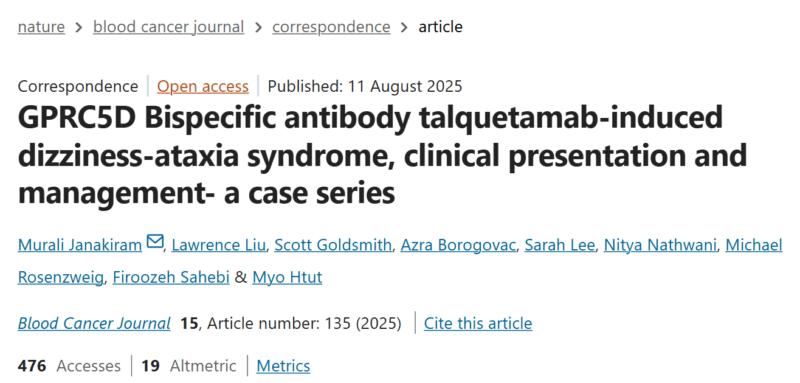Murali Janakiram, Associate Professor at the Division of Hematological Malignancies at City of Hope, shared a post on X about a paper he co-authored with colleagues published in Blood Cancer Journal:
“We want to share this important toxicity profile of GPRC5D BisAb- Talquetamab.
GPRC5D Bispecific antibody talquetamab-induced dizziness-ataxia syndrome, clinical presentation and management- a case series.
We know that GPRC5D is possibly expressed in the inferior olivary nucleus of the cerebellum. This has been previously reported in GPRC5D CART as a cerebellar syndrome.
Here we report 4 patients who presented with dizziness and ataxia with no cerebellar signs initially and extensive inv. r/o other causes
- 2 patients were not rechallenged with talq
- 1 patient, the talq was held and rechallenged at a lower dose and increased frequency with no recurrence of symptoms
- 1 patient continued talq with recurrence of symptoms with doses and later developed cerebellar syndrome
Why call it dizziness-ataxia syndrome?
- This is the first presentation
- Calling it a cerebellar syndrome can make clinicians wait as there are no obvious cerebellar signs at initial presentation
- Waiting can lead to worsening and permanent cerebellar signs
- Hence till we know pathophys. we humbly request to call it dizziness ataxia syndrome.
- It has mostly occurred early within the first 60 days
- We think it is a dose dependent toxicity
- All clinical trials with GPRC5D targeting agents should report this and whether this syndrome was present or not
- Early discontinuation is key
Thanks to all co-authors.”
We are collecting more information on this toxicity, and please reach out.”
Rahul Banerjee, Assistant Professor at Fred Hutchinson Cancer Center and at the University of Washington, shared this post, adding:
“It goes by many names: OSN, non-ICANS neurotox, ‘dizziness-ataxia syndrome’ in Blood Cancer Journal paper below (which I love as a name).
Importantly, it can happen with both GPRC5D bsAbs and CAR-T.
n=4, clear Sx recurrence after re-challenge. Thankfully, stopping tal seems to work!”
Title: GPRC5D Bispecific antibody talquetamab-induced dizziness-ataxia syndrome, clinical presentation and management- a case series
Authors: Murali Janakiram, Lawrence Liu, Scott Goldsmith, Azra Borogovac, Sarah Lee, Nitya Nathwani, Michael Rosenzweig, Firoozeh Sahebi, Myo Htut
You can read the Full Article on Blood Cancer Journal.

More posts featuring Murali Janakiram and Rahul Banerjee.
